Why must a staircase be internal?
Venice has among the many external ones a really surprising external staircase reopened to Venetians and visitors in January 2016: Scala Contarini del Bovolo.
It is a unique combination between a light tower and a high spiral staircase, hidden in a tiny courtyard, recalling biblical visions of Jacob’s ladder and the tower of Babel: a brick tower perforated by Renaissance openings connected on the right of the viewer to 3 airy loggias ending in a panoramic terrace.
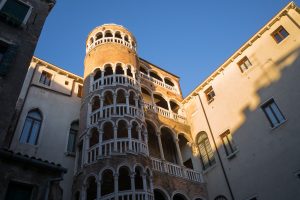
The palace Contarini was built in the Gothic style, unknown is the precise year (some suggest for the Doge Andrea Contarini in the first half of the XIV Century). Documents regarding tithe on property help to date back buildings and ownerships in Venice. 1463 the Senate introduced the tithe on property in order to support the war against the Turks. Unfortunately this documentation was destroyed by a fire, so the next document helping is the new tithe of the year 1514. Pietro Contarini declares owning a building by San Paternian (the old name of the close nearby square nowadays called Manin).
Another important document to Venetians such as the birds’ eye-view of Venice by De Barbari of 1500 shows the already finished staircase.
Shrouded in mystery is also the name of the architect; tradition suggests Giovanni Candi, a ‘marangon’, a carpenter and woodworker, who was paid in 1499 a lot of money – 200 ducats, but not sufficient to cover the cost of a staircase (one historian remembers over 50 years later how the staircase was incredibly expensive).
According to another oral history the architect was Giorgio Spavento who was also commissioned by the same family in 1503 for parts of the close nearby located church of San Salvador.
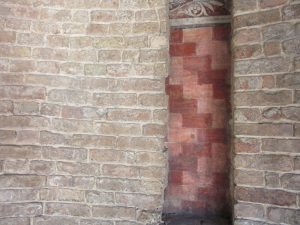
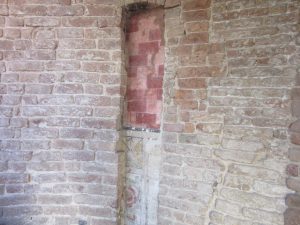
In Italian a spiral staircase is referred to as a snail, the Venetian word is ‘bovolo’ and therefore this nickname was soon given to the family: Contarini of the Snail.
What is the difference between a spiral and a winding staircase?
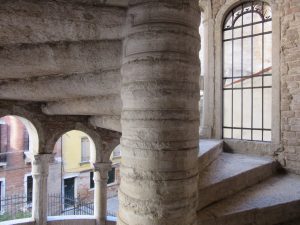
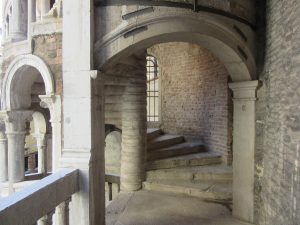
The spiral winds around a central pole as in the case of the Venetian one; a winding staircase instead just winds up along a wall. Technically the difference is in the clear width.
In the first you calculate it as follows :
Radius of the spiral – handrail’s dimension – ray of central pole
in the second
step width – handrail’s dimension + distance from the wall.
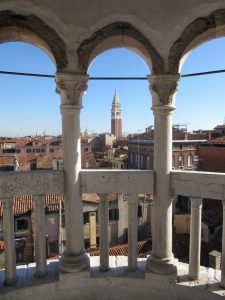
The staircase Contarini is over 26 meters high, 4,70 meters the diameter.
It is a fun experience to climb up, so ascending the over 80 steps counter-clockwise, rather just than using an elevator like in the other two bell towers of Venice.
The view of Venice is really amazing!
Normally a spiral staircase winds clockwise from the point of view of the ascender, so that right-handed attacking swordsmen were in difficulty. A swordsman, normally right-handed, has to engage the central pike and degrade his mobility compared with the defender who is facing down the stairs.
Several staircases date back in Europe to the same time period as the Venetian one :
– The double winding staircase in Graz, Austria was planned in the same years 1499-1500;
– Donato Bramante planned one in 1505 in the Pio Clementine Museum connecting the Belvedere palace of Pope Innocent VIII to the outside (the columns in granite are Doric, the paving with herring-bone pattern) easy to ascend and descend;
– Double spiral staircase in the Castle of Chambord with nearly 300 steps, maybe based on a design by Leonardo da Vinci a few decades later;
– Another one is in Orvieto, Pozzo della Rocca, nowadays known as Pozzo of San Patrizio (248 steps), planned by Antonio Sangallo il Giovane between 1527 and 1537. The story goes that Pope Julius II would be able to reach his residence sitting comfortably in a carriage without having to walk up in his heavy papal dresses;
– Palazzo Barozzi in Vignola by Modena of second half of the XVI Century;
– the staircase of Castle of Castellammare del Golfo close to Trapani leading up to the terrace.
by Fiona Giusto
qualified guide in Venice
www.venicetours.it




